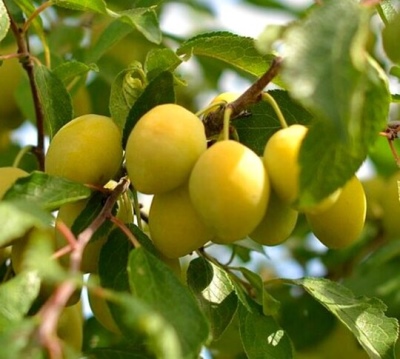
- Authors: folk selection
- Growth type: medium-sized
- Crown: wide, dense, thick
- Tree height, m: up to 4
- Fruit size: large
- Fruit weight, g: 20-30
- Fruit shape: oblong-rounded
- Fruit color: yellow-greenish
- Self-fertility: self-infertile
- Early maturity: 5-year after planting
Plum Ochakovskaya yellow - a variety of fruit trees of national selection, considered one of the best in its group. It is traditionally grown in temperate climates, producing fairly bountiful harvests without the hassle. In some sources, the variety is referred to as Ochakovskaya white or Latvian yellow egg plum.
Description of the variety
The trees of this variety of domestic plum are medium-sized, reaching 4 m in height. Shoots are reddish, inclined to the ground. Crown with dark green leaves, wide, prone to thickening. Flower buds are poorly formed, petals are white, double. Trees grow well both on grafts and when propagated by root suckers.
Fruit characteristics
Fruits for universal use, large in size, each weighing 20-30 g. The shape is traditional, oblong-rounded, the skin is yellow-greenish. The fruits are prone to shedding. The shell is delicate, sensitive to damage.
Taste qualities
Fruits are sweet and sour, pleasant, with juicy tender pulp. Very pleasant to the taste, suitable for processing, fresh consumption. The skin is edible, poorly separated.
Ripening and fruiting
The variety begins to bear fruit 5 years after planting. Medium late plum, bears fruit closer to September.

Yield
The collection of fruits is 40-80 kg from each tree.
Growing regions
The variety is suitable for planting in the Moscow region, in the north-western regions. It grows well in the south, in Siberia and the Urals.
Self-fertility and the need for pollinators
Plum Ochakovskaya yellow is self-fertile. She needs to plant a number of pollinators capable of setting fruit. Can be planted nearby in the garden Renclode Zeleny or Ulena, one of the types of Hungarian or other plums, also blooming at the end of May.
Growing and care
Trees can be planted both in the sun and in partial shade. But they are sensitive to strong winds and other external influences, they need protective shelter. It is customary to plant young plants in spring, autumn for these purposes can be used exclusively in regions with a late onset of cold weather. The preferred soil type is loose, fertile, with a neutral acidity level. Loam and sandy loam are suitable, but with a fairly high nutrient content.
For plants, do not choose a place with a close occurrence of groundwater. Better to place the yellow plum on a hill. When planting in spring, you should try to be in time before the buds begin to bloom on the trees. It is better to choose an annual seedling. Under it there will be enough holes with a depth of 60-70 cm, to the nearest landings there should be at least 3 m, to large-sized ones - about 7 m.
The fruit tree needs feeding as it grows and develops. Fertilizers are applied at the root 1-2 times a year.When planting, they are also laid, adding a bucket of humus and 250 superphosphate over the drainage, and then mixing the dressing with garden soil. The root collar of the plant is placed 30-40 mm above the edge of the hole. Post-planting watering is required using 30 liters of water.
Plant care includes mulching the soil, periodic watering, especially during periods of extreme heat. It is recommended to mulch the trunk circle. Whitewash the bark itself to a height of 1 m; also, young plum trees should be tied to a peg until they are sufficiently strong.




Disease and pest resistance
The variety is characterized by high immune protection. But he still needs preventive treatment against the main fungal diseases, spraying with insecticides as needed.

Despite the fact that the plum is considered to be more hardy than many fruit trees, it is not immune from diseases. It is attacked by viral, fungal and bacterial infections, and parasitic insects harm it. It is necessary to notice and recognize the signs of plum disease in time. They are easier to deal with and defeat early on. Well, in order to protect the garden tree from such a misfortune in the future, preventive procedures can be carried out.
Resistance to soil and climatic conditions
This home plum belongs to winter hardy, not sensitive to the intensity of care, the duration of daylight hours. But it is quite thermophilic; in very cold periods, shoots can freeze out.

Review overview
According to gardeners, the Ochakovskaya yellow plum does not always meet expectations. Old trees gradually reduce the intensity of fruiting, without transplanting they cease to please with abundant harvests. But this variety gives young shoots well, is perfectly pollinated not only by other plums, but also by cherry plum. The palatability of the fruit is also rated very highly, summer residents mention the juiciness, pleasant consistency of the pulp.
The variety is perfect for planting in sufficiently thickened areas, with shading, in old gardens it successfully yields bountiful harvests, but only in the presence of pollinators. Plants do not require frequent watering, abundant feeding. The disadvantages of the variety, gardeners include its low prevalence, difficulty with the acquisition of seedlings. Plants are noticeably inferior to newer varieties in resistance to diseases and pests.Not all summer residents are also satisfied with periodic fruiting.


































































